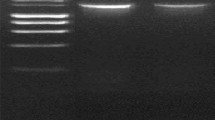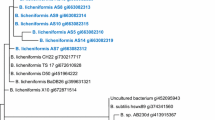Abstract
Waste engine oil pollution is an endemic problem in African countries as waste oil is often discharged into the environment without adequate treatment because waste oil recycling facilities are not readily available. In this study, laboratory-based microcosms (natural attenuation, biostimulation, bioaugmentation and combined treatment of biostimulation–bioaugmentation) were set up with soils (from old hydrocarbon biopiles) spiked with waste engine oil and monitored for 3 months. Total petroleum hydrocarbon analysis showed that biostimulation and biostimulation–bioaugmentation accelerated hydrocarbon degradation with over 84% reduction (<10,000 mg kg−1) by week 8. It took another 2 weeks for other microcosms to get below this classification of low-level contaminated waste and landfill disposal level. The highest degradation rate of 92% was obtained in biostimulated–bioaugmented microcosms (week 10). However, by week 12, there were no significant differences in hydrocarbon levels in naturally attenuated and treated microcosms. 16S rRNA and ITS-based denaturing gradient gel electrophoresis profiling showed diverse bacterial and fungal communities with some dominant members belonging to hydrocarbon-degrading Proteobacteria, Ascomycetes and Basidiomycetes. This research has therefore shown that hydrocarbon-polluted soils possess substantial microbial hydrocarbon-degrading capacity which was successfully harnessed for degrading engine oil. In developing countries without recycling facilities but readily available hydrocarbon-contaminated soils, using such soils for ex situ monitored natural attenuation could be an effective, low-cost and environment-friendly option for treating waste engine oil.



Similar content being viewed by others
References
Abioye, P. O., Aziz, A. A., & Agamuthu, P. (2010). Enhanced biodegradation of used engine oil in soil amended with organic wastes. Water Air Soil Pollution, 209, 173–179.
Adenipekun, C. O. (2008). Bioremediaton of engine-oil polluted soil by Pleurotus tuberregium Singer, a Nigerian white-rot fungus. African Journal of Biotechnology, 7, 55–58.
Adetutu, E. M., Ball, A. S., & Osborn, A. M. (2008). Azoxystrobin and soil interactions: Degradation and impact on soil bacterial and fungal communities. Journal of Applied Microbiology, 105, 1777–1790.
Akoachere, J. F. T. K., Akenji, T. N., Yongabi, F. N., Nkwelang, G., & Ndip, R. N. (2008). Lubricating oil-degrading bacteria in soils from filling stations and auto-mechanic workshops in Buea, Cameroon: Occurrence and characteristics of isolates. African Journal of Biotechnology, 7, 1700–1706.
Anderson, I. C., & Parkin, P. I. (2007). Detection of active soil fungi by RT-PCR amplification of precursor eRNA molecules. Journal of Microbiological Methods, 68, 248–253.
Bento, F. M., Camargo, F. A. O., Okeke, B. C., & Frankenberger, W. T. (2005). Comparative bioremediation of soils contaminated with diesel oil by natural attenuation, biostimulation and bioaugmentation. Bioresource Technology, 96, 1049–1055.
Bundy, J. G., Paton, G. I., & Campbell, C. D. (2004). Combined microbial community level and single species biosensor and responses to monitor recovery of oil polluted soil. Soil Biology and Biochemistry, 36, 1149–1159.
Colgan, W., Patrick, D. R., & Vavrek, M. (2004). Rhizosphere fungal diversity in oil and brine contaminated soils. 11th Annual International Petroleum Environmental Conference.
Di Toro, S., Azanaroli, G., Varese, G. V., Marchisio, V. F., & Fava, F. (2008). Role of enzyveba in the aerobic bioremediation and detoxification of a soil freshly contaminated by two different diesel fuels. International Biodeterioration and Biodegradation, 62, 153–161.
Garcia-Hernandez, D., Sosa-Aguirre, C. R., & Sanchez-Yanez, J. M. (2007). Bioremediation of domestic sewage polluted with waste motor oil. Hydraulic Engineering in Mexico, 22, 113–118.
Ghazali, F. M., Rahman, R. N. Z. A., Salleh, A. B., & Basri, M. (2004). Biodegradation of hydrocarbons in soil by microbial consortium. International Biodeterioration and Biodegradation, 54, 61–67.
Girvan, M. S., Bullimore, J., Pretty, J. N., Osborn, A. M., & Ball, A. S. (2003). Soil type is the primary determinant of the composition of the total and active bacterial communities in arable soil. Applied and Environmental Microbiology, 69, 1800–1809.
Harayama, S., Kasai, Y., & Hara, A. (2004). Microbial communities in oil contaminated sea water. Current Opinion in Biotechnology, 15, 205–214.
ISO (2004). ISO/DIS 16703 GC-method. Soil quality in determination of content of hydrocarbon in the range C10 to C40 by gas chromatography. International Organisation for Standardisation, Geneva, http://www.iso.org/iso/iso_catalogue/catalogue_ics/catalogue_detail_ics.htm?ics1=13&ics2=80&ics3=10&csnumber=39937.
Joo, H., Ndegwa, P. M., Shoda, M., & Phae, C. (2008). Bioremediation of oil-contaminated soil using Candida catenulata and food waste. Environmental Pollution, 156, 891–896.
Jorgensen, K. S., Puutinen, J., & Suortti, A. M. (2000). Bioremediation of petroleum hydrocarbon contaminated soil by composting in biopiles. Environmental Pollution, 107, 245–254.
Kyung-Hwa, B., Yoon, B., Kim, B., Cho, D., Lee, I., Oh, H., et al. (2007). Monitoring of microbial diversity and activity during bioremediation of crude oil-contaminated soil with different treatments. Journal of Microbiology and Biotechnology, 17, 67–73.
Mancera-Lopez, M. E., Esparza-Garcia, F., Chavez-Gomez, B., Rodriguez-Vazques, R., Saucedo-Castaneda, G., & Barrera-Cortes, J. (2008). Bioremediation of an aged hydrocarbon-contaminated soil by a combined system of biostimulation–bioaugmentation with filamentous fungi. International Biodeterioration & Biodegradation, 61, 151–160.
Mandri, T., & Lin, J. (2007). Isolation and characterisation of engine oil degrading indigenous microorganisms in Kwazulu-Natal, South Africa. African Journal of Biotechnology, 6, 23–27.
McKew, B. A., Coulon, F., Osborn, M., Timmis, K. N., & McGenity, T. J. (2007). Determining the identity and roles of oil metabolizing marine bacteria from the Thames estuary, UK. Environmental Microbiology, 9, 165–176.
Muyzer, G., Wall, E., & Utterlinden, A. (1993). Profiling of complex microbial populations by denaturing gradient gel electrophoresis analysis of polymerase chain reaction amplified genes coding for 16S rRNA. Applied and Environmental Microbiology, 59, 695–700.
Nannipieri, P., Ascher, J., Ceccherini, M. T., Landi, L., Pietrmellara, G., & Renella, G. (2003). Microbial diversity and soil functions. European Journal of Soil Science, 54, 655–670.
Odjegba, V. J., & Sadiq, A. O. (2002). Effects of spent engine oil on the growth parameters, chlorophyll and protein levels of Amaranthus hybridus L. The Environmentalist, 22, 23–28.
Rizzo, A. C., da Cunha, C. D., Santos, R. L., Santos, R. M., Magalhaes, H. M., Leite, S. G., et al. (2008). Preliminary identification of the bioremediation limiting factors of a clay bearing soil contaminated with crude oil. Journal of Brazilian Chemical Society, 19, 169–174.
Rowell, D. L. (1994). Soil science: Methods and applications. UK: Longman Scientific and Technical.
Second Independent Review of the Product Stewardship Discussion Paper. (2008). http://www.oilrecycling.gov.au/program/index.html.
Stallwood, B., Shears, J., Williams, P. A., & Hughes, K. A. (2005). Low temperature bioremediation of oil contaminated soil using biostimulation and bioaugmentation with a Pseudomonas sp. from maritime Antarctica. Journal of Applied Microbiology, 99, 794–802.
Udeani, T. K. C., Obroh, A. A., Okwuosa, C. N., Achukwu, P. U., & Azubike, N. (2009). Isolation of bacteria from mechanic workshops’ soil environment contaminated with used engine oil. African Journal of Biotechnology, 8, 6301–6303.
Vazquez-Duhalt, R. (1989). Environmental impact of used motor oil. The Science of the Total Environment, 79, 1–23.
Verdin, A., Lounes-Hadj, S. A., & Durand, R. (2004). Degradation of benzo[a] pyrene by mitosporic fungi and extracellular oxidative enzymes. International Biodeterioration and Biodegradation, 53, 65–70.
Wu, Y., Luo, Y., Zou, D., Ni, J., Liu, W., Teng, Y., et al. (2008). Bioremediation of polycyclic aromatic hydrocarbons contaminated soil with Monilinia sp., degradation and microbial community analysis. Biodegradation, 19, 247–257.
Author information
Authors and Affiliations
Corresponding author
Rights and permissions
About this article
Cite this article
Aleer, S., Adetutu, E.M., Makadia, T.H. et al. Harnessing the Hydrocarbon-Degrading Potential of Contaminated Soils for the Bioremediation of Waste Engine Oil. Water Air Soil Pollut 218, 121–130 (2011). https://doi.org/10.1007/s11270-010-0628-1
Received:
Accepted:
Published:
Issue Date:
DOI: https://doi.org/10.1007/s11270-010-0628-1




